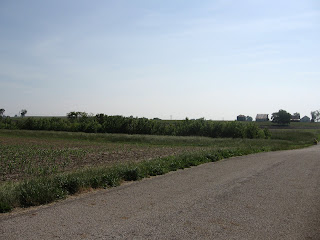The quarry today was a Black Rail, a small, chicken-like bird of marshy wetlands.
This little mite is known to be secretive and can be quite difficult to find. Birders are happy to hear its characteristic "kick-ee-doo" call and count themselves lucky, especially in Ohio, where only 5 Black Rails have been reported in the entire state since 1980.
On June 1, birders were shocked to hear that one, or possibly two, Black Rails were heard at "Charlie's Pond," a small wetlands area south of Circleville in Pickaway County, between Columbus and Chilicothe. Rail enthusiasts from all over the state were raving on the list daily about hearing the rail's calls, and many were convinced there were at least two birds. A lucky few saw it flying, weakly and awkwardly, across the road. [The rail is not sick or injured - they just fly that way.]
Jim McCormac has an excellent discussion of this area of Ohio and its importance in terms of wetland habitat, so I won't try to recreate it here. This is my trip, and I'll tell my side of the story.
This is "Black Rail Country," which, if you didn't know any better, doesn't look like much. It is a low wet area between two farm fields, bisected by a tiny country lane. That strip of green is the most famous spot in Ohio birding right now.

But, when you are chasing, you don't have to be able to recognize prime habitat. You only need to look for one thing - parked cars and people with cameras, binoculars and spotting scopes - to know you are in the right place.


A closer look at "Charlie's Pond," or, should I say, one of two spots which lays claim to the name.
This is the north side of Radcliffe Road
Believe me, if you were a Black Rail, you would think this was heaven.This is a spot just down the road from the Black Rail location, and depending on who you talk to, it is the "true" Charlie's Pond.

And this is the extension of the previous swale (basically, "drainage ditch") that feeds into this version of Charlie's Pond.

I don't really care which one you call the pond, since neither spot held a rail of any sort, much less a Black Rail, today. I arrived at 10:15am, after a drive of 2.5 hours, to find that no one had heard the Black Rail call since dawn. Reports on the list indicate it had been heard Saturday night, about 8:30pm.
Dusk and dawn are much more normal times for Black Rails to call, and it seems the daytime show is now over, for whatever reason. A gentleman from Toledo, who left home at 3:00am and drove 4 hours for this non-sighting, had a good theory: He thought perhaps the birds had established a territory and moved on to the nesting stage, which would mean they didn't need to call as often. I hope its true, even if it means I missed my chance for a Black Rail.
It wasn't a totally wasted trip. Surrounding the wet areas of Charlie's Ponds is grassland habitat, like this:

and it was here I found 1 1/2 Life Birds, both sparrows. I heard Grasshopper Sparrows singing as soon as I stepped out of my car. Having studied my CDs of bird songs on the way down, I immediately recognized the buzzy insect-like trilling sound. Finding the bird took a little bit of time, but eventually I had it in the scope. Just as I was trying to digiscope him, a second Grasshopper Sparrow flew in and the two began duking it out. Both birds flew across the road and vanished.
I walked along the road until I heard a weak "tiz-lik" call. My ears perked up. Twice in the past, at the Cincinnati Nature Center in 2006 and at The Wilds in 2007, I have heard this song, that of a Henslow's Sparrow. I counted it as a "heard-only" Life Bird, but here was my chance to see one. Tracking down the singers took some effort, but I persevered.
These aren't the best photographs, but I was thrilled to get them.
For a bird with a pathetic song, the Henslow's puts his all into the delivery. He puffs his chest out, throws his head back and, well - "hic-cups." There's really no other way to describe it.
Back at the swale on the north side of Radcliffe Road again, and still no Black Rail. Another Life Bird was lurking in the willows - an Alder Flycatcher. Trust me, it was there.

My Trip List for today: (HO = Heard Only)
Great Blue Heron
Turkey Vulture
Ring-necked Pheasant (HO)
Mourning Dove
ALDER FLYCATCHER
Barn Swallow
Tree Swallow
Northern Rough-winged Swallow
Eastern Meadowlark
Red-winged Blackbird
Common Grackle
American Robin
Common Yellowthroat (HO)
Horned Lark
Dicksissel
Song Sparrow
HENSLOW'S SPARROW
GRASSHOPPER SPARROW


That's All, Folks!








1 comment:
I saw your posting on the Ohio listserv and gritted my teeth. Why didn't I try to go see it? Circleville isn't that far.
(and I went there to try and see the Snowy Owl in 2006)
Maybe we can try it when nestlings are there? Wouldn't that be FANTASTIC?
I'm sorry you didn't get to see or hear the Holy Grail Bird of Ohio, 2008 Edition.
:)
Post a Comment